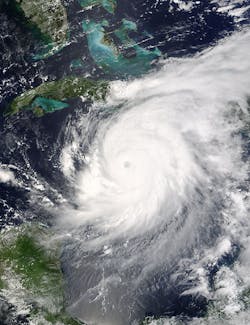2004
<< PREV1234567891011 12 131415161718192021NEXT>>
The 2004 Atlantic hurricane season was notable because more than half of the season's 16 tropical cyclones brushed or struck the United States. The season's Hurricane Charley became the second-costliest in United States history, at the time, after striking Florida as a Category 4, leaving $14 billion in damage. Later in August, Hurricane Frances became the third costliest U.S. hurricane, primarily due to impact in Florida. The most significant storm in terms of intensity and damage was Hurricane Ivan, a Category 5 hurricane that devastated multiple countries adjacent to the Caribbean Sea, before entering the Gulf of Mexico and bringing catastrophic impact to the Gulf Coast of the United States, causing $18.8 billion in losses.
Gilbert Gonzalez heads Mission Critical Solutions, based in Tampa, FL (MCS; www.mcsoftampa.com); MCS was the contractor that got FEMA’s operations running when Hurricane Charley struck in August 2004. In a subsequent interview with Cabling Installation & Maintenance, reprinted here, Gonzalez described the work MCS carried out for FEMA, the contribution his distributor made to the process, and his experiences with preparing for and dealing with natural disasters.
CI&M: FEMA used your services in its efforts to help citizens through recovery from 2004’s Florida hurricanes, including Charley. Had you worked with FEMA in any capacity before the hurricanes?
Gonzalez: FEMA was a new customer of ours. We had been marketing to them before Hurricane Charley, but had not done business with them. When the hurricane hit, their other vendors were unable to respond.
CI&M: The entire country knew the hurricane was bearing down on Florida, thanks to meteorological technology. How far ahead of time were you in touch with FEMA to discuss their anticipated needs? Or, did the contact begin after the hurricane hit?
Gonzalez: We at Mission Critical Solutions were hunkered down in Tampa waiting for the storm to hit, with maps on the wall because even though we knew the storm was coming, nobody knew exactly where it would make landfall. At 3:00 that afternoon, we got the call. FEMA asked, “If we give you an order tomorrow morning, can you get it up and operational 24 hours later?”
CI&M: The scope of work must have been extremely challenging.
Gonzalez: FEMA needed deployable networks that could be moved to various disaster sites. One was set up in an old retail store, and we had to come up with an on-the-fly design for printers, fax machines-all the network components. The network had to be up and operational by noon the day after it was specified. It required 80 computers for two wireless networks, which had to be ordered. I couldn’t wait at my office in Tampa for delivery of the equipment because of the tight timeframe. Fortunately, Graybar (www.graybar.com) had its warehouse in the area up and running. They accepted shipments for me at their site, which allowed me to get to the worksite in time to complete the job.
CI&M: I’m sure you appreciated that level of support from your distributor.
Gonzalez: For many people, you don’t understand the value of having a true relationship with your distributor until you call your distributor at 6:00 AM and ask them to do something that is unreasonable. To me, a relationship isn’t about getting an extra nickel off the price of a jack. There is a hidden benefit to remaining loyal.
CI&M: Recovering from a disaster is a long-term process. What kind of agreement do you have with FEMA for ongoing work?
Gonzalez: MCS is supporting the FEMA centers for 12 months.
CI&M: You landed FEMA as a client as a result of this natural disaster. Did any of your existing customers fare badly in Hurricane Charley?
Gonzalez: A naval facility in Pensacola suffered badly from a later hurricane. More than 20 buildings were destroyed and the initial budget for telecom reconstruction was $20 million.
CI&M: What do you tell your existing customers about disaster-prevention and disaster-recovery plans?
Gonzalez: I tell them it is not impossible; it can be done. When physically possible, the best way to accomplish disaster prevention is to have a geographically diverse site. For small businesses, that is not realistic. I tell them to at least look at the buildings’ construction. Be certain that you will be able to restore power or have access to secondary power. That means a generator and adequate fuel.Very importantly, elevate your equipment. One government client of mine has its telephone switch located in the basement. I told them they have to move the switch onto a higher floor.

